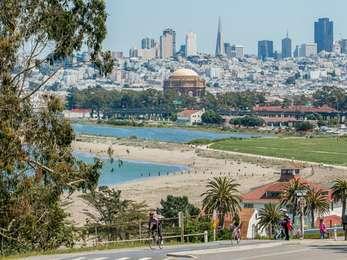Last updated: March 24, 2021
Place
22 - A Wasteland Transformed

WAYSIDE PANEL TITLE: A Wasteland Transformed
PANEL DESCRIPTION: The wayside faces north on the northern side of the trail.
VIEW FROM WAYSIDE: To the north west, across the blue waters of Crissy marsh, is the Golden Gate Bridge and the high peaks of the Marin Headlands. Twenty feet away is a small fence barring access to the marsh waters and a tall, bushy willow and other coastal plant species. There is a small clearing directly in front of the wayside. Three feet to your right is a trash can.
TEXT: The Presidio Quartermaster Depot. From the 1870s until the early 1900s, the Presidio Quartermaster Depot at this site stored provisions and equipment for the soldiers stationed here. Two wharves gave supply ships access to the depot. Warehouses and stables covered the area and trash was dumped in the adjacent marsh, considered a wasteland at that time. In 1912, the marsh was completely filled, creating a foundation for the Panama-Pacific International Exposition of 1915 and subsequently for the Crissy airfield.
DESCRIPTION OF IMAGE #1: To the right of the text at the top center of the panel is a black and white photo of several men standing next to six overturned carriages with wooden spoke wheels. Behind them are three long, two-story buildings at the intersection of a wide street.
CAPTION: Barracks and supply buildings at the northern-most end of the Quartermaster Depot area, ca. 1898.
DESCRIPTION OF IMAGE #2: At the bottom of the panel are three photos of objects side by side. On the left, is a clear, glass bottle with raised lettering that reads, "Rubifoam for the Teeth, Put Up by E.W. Hoyt & Co., Lowell, Mass." To the right of the bottle is an advertisement with the image of a blonde woman with a headband covered in daisies on her head, with long, curly blonde hair. Around her neck is a white silk scarf and she's holding two kittens and four pink flowers in her lap. She's smiling so that her top row of teeth shows. She's encircled by an oval frame, which sits in the middle of a portrait-oriented rectangle. The rectangle has a green trim, with the words "The Teeth, their care and preservation," at the top, and "E.W. Hoyt & Co., Lowell Mass" along the bottom. To the right of the advertisement is a white bowl with a gold ring around its outer lip. On its base is the image of a crossed sword with hilt, and a shovel. The characters "4" and "B" appear above and below the space where the sword and shovel cross, respectively.
CAPTION: Archaeological artifacts are important remnants of historic sites, buildings and landscapes and help tell the stories of earlier people. Removing them damages culturally significant sites piece by piece. Artifacts are protected under federal law. Please leave them in place!
DESCRIPTION OF IMAGE IN #3: In the bottom right corner of the panel is a photo of two men in coats, sunglasses and brimmed hats standing facing one another with a table between them. They're both facing down at the table, sifting through several small, metal objects.
CAPTION: During construction of the new tidal marsh in 1999, archaeologists recovered much of the historic refuse dumped in the former marsh. These artifacts enhance our understanding of daily life at the Presidio.
TEXT: A Strategic and Useful Site. Long before the Presidio became a U.S. military post, this waterfront site hosted a succession of human events. Originally a system of marshes, it was a seasonal home to native Ohlone people for thousands of years. In the 18th century, Spanish sailors came ashore here. Russian, English and Boston traders negotiated deals on this shore in the early 19th century, and in 1846, Americans led by John C. Fremont landed on this waterfront to silence the cannon at the Mexican Castillo, where Fort Point was later built.
